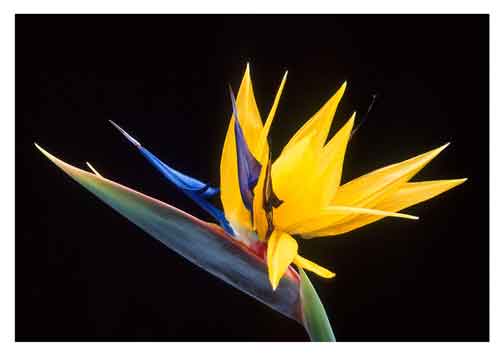 Gen info Gen info
- Strelitzia is a genus of five species of perennial plants, native to South Africa (Strelitzia alba, S. juncea, S. nicolai, S. caudate, S. reginae).
-
The species was first described in 1788 by Sir Joseph Banks.
-
Etymology: The genus name Stelitzia honors Queen Charlotte, wife of George III, from the house of Mecklenburg-Strelitz.
- Strelitzia reginae is shown to be paraphyletic as S. juncea is genetically nested within it. It is possibly a mutation in the process of speciating. (3)
- Designated the official flower of the City of Los Angeles. (3) In 1952, it was declared LA's floral emblem by Mayor Fletcher Bowron to celebrate the city's 171st birthday. (3)
- It is also featured on the reverse of the South-African 50-cent coin.
Botany
Bird-of-paradise is a perennial plant growing to a height of 2 meters. Leaves are large, up to 70 centimeters long and 30 centimeters wide on petioles up to 1 meter long. Leaves are evergreen, arranged in two ranks in a fan-shaped crown. Flowers stand above the foliage at the tips of long stalks. The spathe from which the flower emerges is perpendicular to the stem giving the appearance of a bird's head and beak. Flowers are showy with three brilliant orange sepals and three purple or blue petals. S. Seeds with black with vivid orange arils. (3) (8)
 Distribution Distribution
- Introduced.
-
Native to South Africa.
- Widely naturalized globally as an ornamental plant.
Constituents
- Phytochemical analysis of rhizomes of S. reginae isolated an unusual new (1) and four known phenalenone-type compounds. (5)
- Delphinidin-3-rutinoside (used for color) has been isolated from the petals and proanthoncyanidin polymers (flavonoids, antioxidants) from the leaves.
- Floral pigments include carotenoids and the anthocyanin-3-rutinoside. Study have shown bilirubin is the primary aril pigment and is also present in low concentrations in the sepals. (8)
- Study of leaf extract revealed primary metabolites such as carbohydrates, proteins, oils, and fats, and secondary metabolites such as phenols, flavonoids, steroids, saponins, alkaloids, tannins, and glycosides.
(9)
Parts used
Roots, inflorescence.
Uses
Folkloric
- No known folkloric medicinal use in the Philippines.
- In South African traditional medicine roots are used for treatment of urinary tract infections (UTIs) and sexually transmitted diseases (STDs). The Zulus use decoction of crushed roots used to relieve symptoms of STDs. Strained decoctions from inflorescence used to treat inflamed glands and venereal diseases. Seeds used to sour milk. (3) (5)
- The abakwa Mthethwa clan in KwaZulu-Natal use the strained decoctions from the inflorescence to treat inflamed glands and venereal diseases. In the cape, seeds are used to sour milk. (11)
Others
- Ornamental: Widely used ornamental plant.
 Studies Studies
• Flower Nectar: Study of nectar of Strelitzia reginae using enzymatic methods yielded glucose,, fructose, and sucrose. The sugar composition changed considerably over the nectar producing period, with increase in glucose (51%) and fructose (32%) between early and middle stage of secretion, and a 13 and 24$ decrease, respectively, towards the end. (4)
• Pigments / Bilirubin: Floral pigments include carotenoids and anthocyanin delphinidin-3-rutinoside. Study discovered bilirubin in the arils of S. nicolai. HPLC and HPLC/electrospray ionization-tandem mass spectrometry show that bilirubin is the primary aril pigment and is also present in low concentrations in its sepals (less than 44.0 ng/g. (8)
• Antioxidant / Leaves: Study evaluated the antioxidant activity of methanolic extract of air-dried leaves. Phytochemical screening yielded flavonoids, tannins, alkaloids, and carbohydrates. By DPPH and H2O2 showed significant radical scavenging activity with high percentage scavenging inhibition. Highest phenolic content of 56.62 mg was found on 100 mg% concentration, 39.52 and 34.62 mg with 75mg% and50mg% concentrations, respectively. (10)
• Prolongation of Post-Harvest Life: Study evaluated the effect of two different biologically synthesized nanoparticles. The novel proprietary stimulants were graphene oxide (GO) and silver nanoparticles (SNPs). Administration of NPs showed better results for all analyzed parameters. Application of biologically synthesized NPs in combination (GO+SNPs) extended cut flowers by 6 days compared to control, and overall, showed better results. (12)
• Cellulosic Fiber for Reinforcement of Polymer Composites / Stem: Study evaluated the usability of new cellulosic fibers extracted from the stem of Strelitzia reginae, as a potential reinforcement for polymer composites. Various tests including thermogravimetry, tensile strength, and infrared analysis concluded that S. reginae fibers could serve as possible reinforcement in composite materials. (13)
Availability
- Wild-crafted.
- Ornamental cultivation.
- Seeds in the cybermarket.
|

![]()



 Gen info
Gen info Distribution
Distribution Studies
Studies 